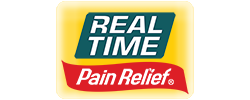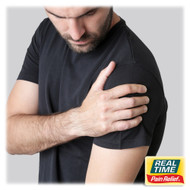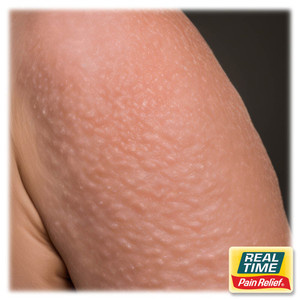6 Tips to Cope with a Frozen Shoulder
31st Aug 2022
Dealing with a frozen shoulder? Fortunately, there are things you can do to ease pain and stiffness. We have found 6 tips to help you cope with it!
If you have shoulder pain and stiffness, it might be due to a condition called adhesive capsulitis, which is commonly called frozen shoulder. If you deal with a frozen shoulder, it may take several months or even longer for symptoms to resolve. Fortunately, there are things you can do to ease pain and stiffness.
What Is a Frozen Shoulder?
Your shoulder joint is surrounded by connective tissue, referred to as the shoulder capsule. Synovial fluid also surrounds the joint, which lubricates it and makes it easier to move.
Frozen shoulder may develop when the shoulder capsule becomes inflamed, tight, and less synovial fluid surrounds the joint. The result is the formation of thick bands of tissue, called adhesions, inside the capsule, which makes the joint stiff and painful.
Symptoms
Symptoms of frozen shoulder include:
- Pain, which may worsen at night
- Stiffness
- Reduced range of motion
Typically, symptoms start gradually over time and come in three stages and include the following:
- Freezing stage: This stage causes pain in the shoulder with any movement. Range of motion starts to decrease.
- Frozen stage: Although pain may start to decrease during this stage, range of motion continues to become worse, and the shoulder is stiffer.
- Thawing stage: The ability to move the shoulder improves gradually.
Causes and Risks
Anyone can develop a frozen shoulder, and the exact cause is not known. But there are certain factors that appear to increase your risk, including:
- Age: According to the American Academy of Orthopaedic Surgeons, the condition occurs more often in people between 40 and 60. It’s also more common in women.
- Immobility: Frozen shoulder is associated with the immobility of the shoulder for an extended period of time, such as with a broken arm or after shoulder surgery.
- Certain Systemic Diseases: According to the Mayo Clinic, having certain systemic diseases, such as diabetes and Parkinson’s disease, also may increase your risk of frozen shoulder.
6 Tips to Cope with a Frozen Shoulder
Each stage of a frozen shoulder may last months. It could take over a year or more for the condition to resolve. But treatment may help ease stiffness and pain and help you cope with the problem. Consider the following tips:
#1) Try Physical Therapy
Physical therapy is often recommended to help improve range of motion and decrease stiffness. A physical therapist may suggest stretching and strengthening exercises to help speed healing. Talk to your doctor to determine if physical therapy is right for you.
#2) Apply a Pain-Relieving Lotion
A pain relief lotion is one option that may decrease soreness and stiffness without worrying about the side effects of non-steroidal anti-inflammatory medications. Topical pain relief lotions may help ease stiffness and discomfort. Choose a lotion that contains ingredients, such as menthol, chondroitin, and capsicum. Apply a liberal coat of the lotion to the shoulder area and wait a few minutes. Reapply a second coat if needed.
#3) Perform Stretches
Stretches may help improve range of motion and reduce stiffness. There are various shoulder stretches that may be useful, such as the cross-arm stretch.
To do the stretch:
- Use the arm on the same side as the frozen shoulder and place it across your body at about chest level
- Next, use your opposite arm to support the crossed arm at the elbow and pull it slightly further across your body until you feel a stretch in your shoulder
- Hold the stretch for about 20 seconds
#4) Apply Ice
Ice is often used to treat a variety of injuries, and it may help ease pain associated with a frozen shoulder. Place an ice pack on the shoulder for about 10 to 15 minutes a few times a day.
#5) Use Caution with Over-the-Counter Non-Steroidal Anti-Inflammatory Medications
Depending on the severity of the pain, over the counter, non-steroidal medication may be a short-term option. But medications can have side effects and may not be appropriate for everyone. Since symptoms of frozen shoulder can last for many months, regularly taking non-steroidal anti-inflammatory medications may not be advised and should be used with caution.
#6) Consider Steroid Injections
If home treatment does not work and physical therapy is not improving your shoulder, steroid injections may help. The medication is injected into the shoulder joint and reduces inflammation. Steroid injections should be performed with caution since the medication can have side effects, such as nerve damage and weakening of the tendons.
In most cases of frozen shoulder, home treatment and physical therapy is enough to improve the condition. But if treatment does not work and pain, stiffness, and reduced range of motion continue, surgery may be the last resort.
Prevention
Since the exact cause of frozen shoulder is not clear, it may not always be possible to prevent the condition from developing. But since immobility is linked to it, if you sustain an injury that limits shoulder movement, ask your doctor about stretches and exercises to maintain range of motion and hopefully prevent a frozen shoulder.
Pain Relief You Can Trust® Since 1998
For over 20 years, families across the U.S. have turned to Real Time’s lotions and creams for PAIN RELIEF YOU CAN TRUST®. From Lifestyle Essentials, through our Nujuvena line, to Pain Relief Formulas, Real Time has you covered. LEARN MORE
References:
- https://www.health.harvard.edu/shoulders/frozen-shoulder
- https://www.cedars-sinai.org/health-library/diseases-and-conditions/b/bursitis-of-the-shoulder.html
- https://orthoinfo.aaos.org/en/diseases--conditions/frozen-shoulder
- https://www.mayoclinic.org/diseases-conditions/frozen-shoulder/symptoms-causes/syc-20372684#:~:text=One%20of%20the%20most%20common,motion%20in%20your%...





